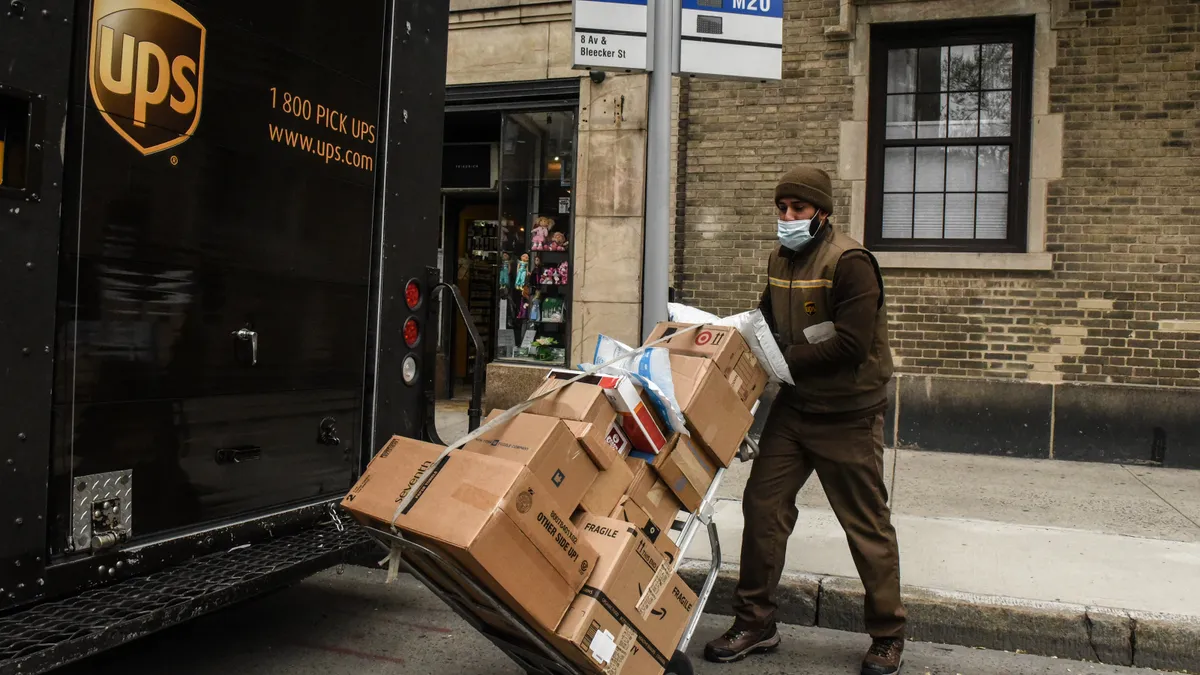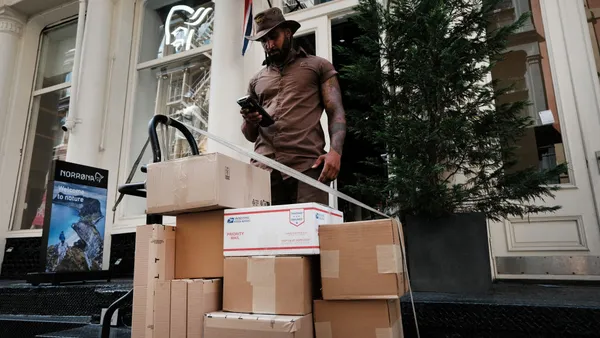Dive Brief:
- The on-time rate for last-mile retail deliveries from the major parcel carriers improved in October, increasing by 2 percentage points from September, according to data from Convey by project44. That's still below the 2021 high of 83% in June and July, however.
- FedEx's on-time rate improved by 5 percentage points from September to 72%, "due to operational improvements and increased accuracy in delivery time estimates," according to Convey. The on-time rates for UPS (83%) and the U.S. Postal Service (92%) declined over the same period.
- Convey said staffing shortages and upstream supply chain issues are slowing deliveries. "Carriers are bracing for a tough season ahead," as on-time rates are unlikely to improve during the holidays, it said.
On-time delivery rate improves for FedEx, slips for UPS in October
Dive Insight:
Parcel carriers are attempting to add tens of thousands of seasonal employees to service the peak-season volume surge in a hiring environment many companies say is challenging. Low staffing levels in FedEx's Ground network have forced the company to reroute more than 600,000 packages per day.
At the same time, port congestion and other supply chain hurdles could stymie the flow of volume entering last-mile carriers' networks. This is already happening for UPS' domestic network, with its hubs near ports in Los Angeles and Long Beach in California waiting for more containers to arrive.
This difficult supply chain environment — on top of sky-high demand for home delivery — has parcel carriers investing more in their sortation networks and advising high-volume shippers to bring in packages earlier or on less-busy days. Many shippers are diversifying their carrier mixes to avoid surcharges and volume limitations.
The upcoming peak season will put those tactics to the test. Convey's data shows that on-time performance has slipped since the summer, and the firm said a challenging holiday stretch for carriers could be coming.
Convey said its October data comes from tens of millions of packages shipped from more than 500,000 North America locations. Convey's methodology aims to measure carrier performance versus consumer expectations. It counts a delivery as late if it misses its original estimated delivery date, an approach ShipMatrix President Satish Jindel has disagreed with, as the carrier wasn't necessarily given the parcel the same day the order occurred.
Some carriers occasionally revise the estimated delivery date once an item is in transit, an issue Convey says has appeared more often during the COVID-19 pandemic and makes a difference in terms of on-time delivery percentages.
"In this model, the 'low-90's' reported at the beginning of the pandemic really looked closer to the mid-70s and was much more consistent with the widespread reports of delays across the nation and with the collective consumer experience," said a post on Convey's website.
Spokespeople for FedEx, UPS and the Postal Service didn't comment on Convey's specific methodologies or findings but said their respective carriers are prepared to handle the upcoming surge in volume.
"UPS led the industry in on-time delivery performance last peak season, and we are confident that our network is running extremely well as we head into this year's peak season," Glenn Zaccara, vice president of communications for UPS, said in an email.
FedEx said in a statement that it is working closely with customers to understand their volume levels and ways to best leverage its network flexibility.
"Despite the challenges we face, the average transit time for all FedEx Ground shipments is still less than 2.5 days," the company said.














